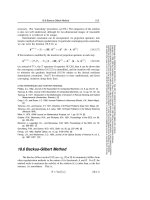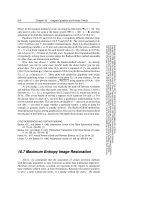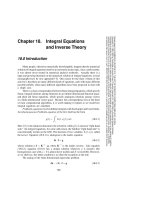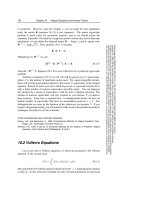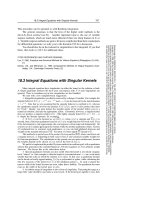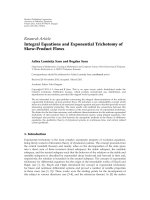Integral Equations and Inverse Theory part 7
Bạn đang xem bản rút gọn của tài liệu. Xem và tải ngay bản đầy đủ của tài liệu tại đây (74.39 KB, 4 trang )
18.6 Backus-Gilbert Method
815
Sample page from NUMERICAL RECIPES IN C: THE ART OF SCIENTIFIC COMPUTING (ISBN 0-521-43108-5)
Copyright (C) 1988-1992 by Cambridge University Press.Programs Copyright (C) 1988-1992 by Numerical Recipes Software.
Permission is granted for internet users to make one paper copy for their own personal use. Further reproduction, or any copying of machine-
readable files (including this one) to any servercomputer, is strictly prohibited. To order Numerical Recipes books,diskettes, or CDROMs
visit website or call 1-800-872-7423 (North America only),or send email to (outside North America).
necessary. (For “unsticking” procedures, see
[10]
.) The uniqueness of the solution
is also not well understood, although for two-dimensional images of reasonable
complexity it is believed to be unique.
Deterministic constraints can be incorporated, via projection operators, into
iterative methods of linear regularization. In particular, rearranging terms somewhat,
we can write the iteration (18.5.21) as
u
(k+1)
=[1−λH] ·
u
(k)
+ A
T
· (b − A ·
u
(k)
)(18.5.27)
If the iteration is modified by the insertion of projection operators at each step
u
(k+1)
=(P
1
P
2
···P
m
)[1 − λH] ·
u
(k)
+ A
T
· (b − A ·
u
(k)
)(18.5.28)
(or, instead of P
i
’s, the T
i
operators of equation 18.5.26), then it can be shown that
the convergence condition (18.5.22) is unmodified, and the iteration will converge
to minimize the quadratic functional (18.5.6) subject to the desired nonlinear
deterministic constraints. See
[7]
for references to more sophisticated, and faster
converging, iterations along these lines.
CITED REFERENCES AND FURTHER READING:
Phillips, D.L. 1962,
Journal of the Association for Computing Machinery
, vol. 9, pp. 84–97. [1]
Twomey, S. 1963,
Journal of the Association for Computing Machinery
, vol. 10, pp. 97–101. [2]
Twomey, S. 1977,
Introduction to the Mathematics of Inversion in Remote Sensing and Indirect
Measurements
(Amsterdam: Elsevier). [3]
Craig, I.J.D., and Brown, J.C. 1986,
Inverse Problems in Astronomy
(Bristol, U.K.: Adam Hilger).
[4]
Tikhonov, A.N., and Arsenin, V.Y. 1977,
Solutions of Ill-Posed Problems
(New York: Wiley). [5]
Tikhonov, A.N., and Goncharsky, A.V. (eds.) 1987,
Ill-Posed Problems in the Natural Sciences
(Moscow: MIR).
Miller, K. 1970,
SIAM Journal on Mathematical Analysis
, vol. 1, pp. 52–74. [6]
Schafer, R.W., Mersereau, R.M., and Richards, M.A. 1981,
Proceedings of the IEEE
, vol. 69,
pp. 432–450.
Biemond, J., Lagendijk, R.L., and Mersereau, R.M. 1990,
Proceedings of the IEEE
, vol. 78,
pp. 856–883. [7]
Gerchberg, R.W., and Saxton, W.O. 1972,
Optik
, vol. 35, pp. 237–246. [8]
Fienup, J.R. 1982,
Applied Optics
, vol. 15, pp. 2758–2769. [9]
Fienup, J.R., and Wackerman, C.C. 1986,
Journal of the Optical Society of America A
,vol.3,
pp. 1897–1907. [10]
18.6 Backus-Gilbert Method
The Backus-Gilbert method
[1,2]
(see, e.g.,
[3]
or
[4]
for summaries) differs from
other regularization methods in the nature of its functionals A and B.ForB,the
method seeks to maximize the stability of the solutionu(x) rather than, in the first
instance, its smoothness. That is,
B≡Var [u( x )] (18.6.1)
816
Chapter 18. Integral Equations and Inverse Theory
Sample page from NUMERICAL RECIPES IN C: THE ART OF SCIENTIFIC COMPUTING (ISBN 0-521-43108-5)
Copyright (C) 1988-1992 by Cambridge University Press.Programs Copyright (C) 1988-1992 by Numerical Recipes Software.
Permission is granted for internet users to make one paper copy for their own personal use. Further reproduction, or any copying of machine-
readable files (including this one) to any servercomputer, is strictly prohibited. To order Numerical Recipes books,diskettes, or CDROMs
visit website or call 1-800-872-7423 (North America only),or send email to (outside North America).
is used as a measure of how much the solutionu(x) varies as the data vary within
their measurement errors. Note that this variance is not the expected deviation of
u(x) from the true u(x) — that will be constrained by A — but rather measures
the expected experiment-to-experiment scatter among estimatesu(x) if the whole
experiment were to be repeated many times.
For A the Backus-Gilbert method looks at the relationship between the solution
u(x) and the true function u(x), and seeks to make the mapping between these as
close to the identity map as possible in the limit of error-free data. The method is
linear, so the relationship between u(x) and u(x) can be written as
u(x)=
δ(x, x
)u(x
)dx
(18.6.2)
for some so-called resolution function or averaging kernel
δ(x, x
). The Backus-
Gilbert method seeks to minimize the width or spread of
δ (that is, maximize the
resolving power). A is chosen to be some positive measure of the spread.
While Backus-Gilbert’s philosophyis thus rather different from that of Phillips-
Twomey and related methods, in practice the differences between the methods are
less than one might think. A stable solution is almost inevitably bound to be
smooth: The wild, unstable oscillations that result from an unregularized solution
are always exquisitely sensitive to small changes in the data. Likewise, making
u(x) close to u(x) inevitably will bring error-free data into agreement with the
model. Thus A and B play roles closely analogous to their corresponding roles
in the previous two sections.
The principal advantage of the Backus-Gilbert formulation is that it gives good
control over just those properties that it seeks to measure, namely stability and
resolving power. Moreover, in the Backus-Gilbert method, the choice of λ (playing
its usual role of compromise between A and B) is conventionally made, or at least
can easily be made, before any actual data are processed. One’s uneasiness at making
a post hoc, and thereforepotentiallysubjectively biased, choice of λ is thus removed.
Backus-Gilbert is often recommended as the method of choice for designing, and
predicting the performance of, experiments that require data inversion.
Let’s see how this all works. Starting with equation (18.4.5),
c
i
≡ s
i
+ n
i
=
r
i
(x)u(x)dx + n
i
(18.6.3)
and building in linearity from the start, we seek a set of inverse response kernels
q
i
(x) such that
u(x)=
i
q
i
(x)c
i
(18.6.4)
is the desired estimator of u(x). It is useful to define the integrals of the response
kernels for each data point,
R
i
≡
r
i
(x)dx (18.6.5)
18.6 Backus-Gilbert Method
817
Sample page from NUMERICAL RECIPES IN C: THE ART OF SCIENTIFIC COMPUTING (ISBN 0-521-43108-5)
Copyright (C) 1988-1992 by Cambridge University Press.Programs Copyright (C) 1988-1992 by Numerical Recipes Software.
Permission is granted for internet users to make one paper copy for their own personal use. Further reproduction, or any copying of machine-
readable files (including this one) to any servercomputer, is strictly prohibited. To order Numerical Recipes books,diskettes, or CDROMs
visit website or call 1-800-872-7423 (North America only),or send email to (outside North America).
Substituting equation (18.6.4) into equation (18.6.3), and comparing with equation
(18.6.2), we see that
δ(x, x
)=
i
q
i
(x)r
i
(x
)(18.6.6)
We can require this averaging kernel to have unit area at every x, giving
1=
δ(x, x
)dx
=
i
q
i
(x)
r
i
(x
)dx
=
i
q
i
(x)R
i
≡ q(x) · R (18.6.7)
where q(x) and R are each vectors of length N, the number of measurements.
Standard propagation of errors, and equation (18.6.1), give
B = Var[u ( x )] =
i
j
q
i
(x)S
ij
q
j
(x)=q(x)·S·q(x)(18.6.8)
where S
ij
is the covariance matrix (equation 18.4.6). If one can neglect off-diagonal
covariances (as when the errors on the c
i
’s are independent), then S
ij
= δ
ij
σ
2
i
is diagonal.
We now need to define a measure of the width or spread of
δ(x, x
) at each
value of x. While many choices are possible, Backus and Gilbert choose the second
moment of its square. This measure becomes the functional A,
A≡w(x)=
(x
−x)
2
[
δ(x, x
)]
2
dx
=
i
j
q
i
(x)W
ij
(x)q
j
(x) ≡ q(x) · W(x) · q(x)
(18.6.9)
where we have here used equation (18.6.6) and defined the spread matrix W(x) by
W
ij
(x) ≡
(x
− x)
2
r
i
(x
)r
j
(x
)dx
(18.6.10)
The functions q
i
(x) are now determined by the minimization principle
minimize: A + λB = q(x) ·
W(x)+λS
·q(x)(18.6.11)
subject to the constraint (18.6.7) that q(x) · R =1.
The solution of equation (18.6.11) is
q(x)=
[W(x)+λS]
−1
·R
R·[W(x)+λS]
−1
·R
(18.6.12)
(Reference
[4]
gives an accessible proof.) For any particular data set c (set of
measurements c
i
), the solutionu(x) is thus
u(x)=
c·[W(x)+λS]
−1
·R
R·[W(x)+λS]
−1
·R
(18.6.13)
818
Chapter 18. Integral Equations and Inverse Theory
Sample page from NUMERICAL RECIPES IN C: THE ART OF SCIENTIFIC COMPUTING (ISBN 0-521-43108-5)
Copyright (C) 1988-1992 by Cambridge University Press.Programs Copyright (C) 1988-1992 by Numerical Recipes Software.
Permission is granted for internet users to make one paper copy for their own personal use. Further reproduction, or any copying of machine-
readable files (including this one) to any servercomputer, is strictly prohibited. To order Numerical Recipes books,diskettes, or CDROMs
visit website or call 1-800-872-7423 (North America only),or send email to (outside North America).
(Don’t let this notation mislead you into inverting the full matrix W(x)+λS.You
only need to solve for some y the linear system (W(x)+λS)·y=R,andthen
substitute y into both the numerators and denominators of 18.6.12 or 18.6.13.)
Equations (18.6.12) and (18.6.13) have a completely different character from
thelinearly regularizedsolutionsto (18.5.7) and (18.5.8). The vectors and matrices in
(18.6.12) all have size N, the number of measurements. There is no discretization of
the underlyingvariable x,soMdoes not come into play at all. One solves a different
N × N set of linear equations for each desired value of x. By contrast, in (18.5.8),
one solves an M × M linear set, but only once. In general, the computational burden
of repeatedly solving linear systems makes the Backus-Gilbert method unsuitable
for other than one-dimensional problems.
How does one choose λ within the Backus-Gilbert scheme? As already
mentioned, you can (in some cases should) make the choice before you see any
actual data. For a given trial value of λ, and for a sequence of x’s, use equation
(18.6.12) to calculate q(x); then use equation (18.6.6) to plot the resolutionfunctions
δ(x, x
) as a function of x
. These plots will exhibit the amplitude with which
different underlying values x
contribute to the pointu(x) of your estimate. For the
same value of λ, also plot the function
Var [u( x)] using equation (18.6.8). (You
need an estimate of your measurement covariance matrix for this.)
As you change λ you will see very explicitly the trade-off between resolution
and stability. Pick the value that meets your needs. You can even choose λ to be a
function of x, λ = λ(x), in equations (18.6.12) and (18.6.13), should you desire to
do so. (This is one benefit of solving a separate set of equations for each x.) For
the chosen value or values of λ, you now have a quantitative understanding of your
inverse solution procedure. This can prove invaluable if — once you are processing
real data — you need to judge whether a particular feature, a spike or jump for
example, is genuine, and/or is actually resolved. The Backus-Gilbert method has
found particular success among geophysicists, who use it to obtain information about
the structure of the Earth (e.g., density run with depth) from seismic travel time data.
CITED REFERENCES AND FURTHER READING:
Backus, G.E., and Gilbert, F. 1968,
Geophysical Journal of the Royal Astronomical Society
,
vol. 16, pp. 169–205. [1]
Backus, G.E., and Gilbert, F. 1970,
Philosophical Transactions of the Royal Society of London
A
, vol. 266, pp. 123–192. [2]
Parker, R.L. 1977,
Annual Review of Earth and Planetary Science
, vol. 5, pp. 35–64. [3]
Loredo, T.J., and Epstein, R.I. 1989,
Astrophysical Journal
, vol. 336, pp. 896–919. [4]
18.7 Maximum Entropy Image Restoration
Above, we commented that the association of certain inversion methods
with Bayesian arguments is more historical accident than intellectual imperative.
Maximum entropy methods, so-called, are notorious in this regard; to summarize
these methods without some, at least introductory, Bayesian invocations would be
to serve a steak without the sizzle, or a sundae without the cherry. We should
